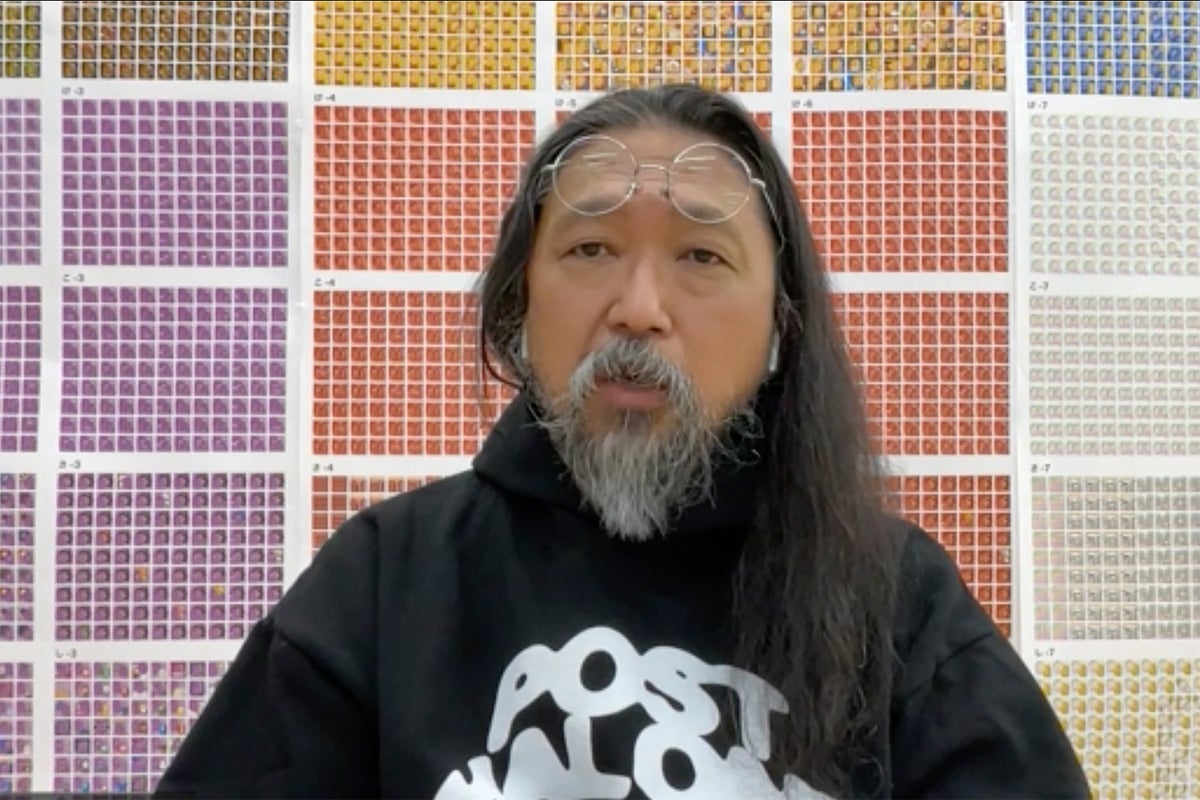
Japanese artist Takashi Murakami’s visions have spanned colorful smiling flowers, a zany take on Mickey Mouse and huge erotic sculptures of animation-inspired figures that have fetched enormous auction prices.
His latest goes down a musical path, in collaboration with American rapper and singer Post Malone.
“To be honest, I really began to listen to him after the pandemic struck, and we were stuck at home all day. I became a big fan,” Murakami said, referring to the social restrictions and emotional stress that came with COVID-19.
Murakami created various artworks and products, featured in a pop-up store in Los Angeles, during Malone’s tour for his latest album, “Twelve Carat Toothache.”
The custom-designed T-shirts, hoodies and trucker hats, as well as mugs and other goods, are also available online, starting Monday, at the NTWRK, a U.S. shopping livestream service.
Malone’s music gets him humming along, like karaoke, filling him with a positive feeling, he said in an online interview with The Associated Press.
“It’s mellow, yet the sound is complex. It’s at the height of hip hop music, yet it’s got a real melody. I fell in love with his sound,” said Murakami.
Typical of the spirit of their collaboration is an image that places Murakami’s flower image next to the butterfly, Malone’s symbol, to become two eyes over a curve: a smiley face that winks.
“It’s a flower and a butterfly, like a marriage,” said Murakami.
Malone expressed delight at the collaborative pieces in a video of their meeting earlier this month.
Murakami has collaborated with other musicians, including Pharrell Williams and Drake. Hip hop, dance music and other contemporary American music are important sources of inspiration for Murakami. He often plays music when he is drawing to get “his brain juices going,” he said.
But when his business was on verge of bankruptcy, right after the pandemic started, he was listening to Rachmaninoff all the time. As time passed, people opened up to investing and even sought art as part of the healing process. Sales jumped and his business recovered, Murakami recalled.
Known as the “Andy Warhol of Japan,” Murakami has exhibited at Rockefeller Center in New York and the Palace of Versailles in France, winning both praise and criticism for his unabashed commercialism.
Murakami has about 200 assistants to help create large-scale artworks at times, be it laughing flowers, psychedelic skulls or deformed old men. His signature icon, which some say is a self-portrait but he insists is just a part of himself like all his artworks, is the Mickey Mouse-like “Mr. DOB.”
A student of traditional Japanese painting at the prestigious Tokyo University of the Arts, Murakami’s art is rooted in the Japanese legacy of the Edo-era woodblock-print masters.
Murakami coined the term “Superflat” to describe his style, linking with such history, exemplified in the emphasis on distinct outlines, which contrasts with Western art’s more realistic perspective and form.
It’s fitting that another dazzling artwork he has created recently is a huge curtain at Tokyo’s Kabuki theater, a traditional performance art that combines dance, music and acting, dating to the 17th century.
Murakami’s depictions of the various roles the featured star actor plays, such as samurai and street peddlers, in his manga-like style, are splattered across a huge cloth over the whole stage.
Usually, Kabuki curtains depict flowers and birds, always more calmly, and sparsely.
Murakami feels he is most unappreciated in his home country. He thinks Japanese don't like that his work is assertive and brash, not fluffy cute.
While based in Saitama, north of Tokyo, he has always been more in demand abroad. He will be in Dubai and Indonesia next. He is a superstar in China.
Murakami’s face becomes a bit sad when he says he expects to have only several years left to do his art. His father got Alzheimer’s at 70. Murakami is 60. He thinks that fate is in his genes.
“I’ve thought a lot about the true purpose of being an artist, and I think it’s to leave information for the future what the artist sees in the real world. My jobs is to leave, through my own filter, what I see,” he said.
“That is what I want to keep doing.”







